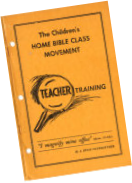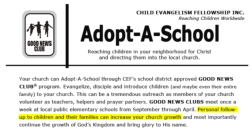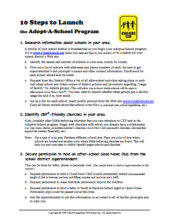CEF’s post-Milford Public School Strategy
Origins as a “Home Bible Class Movement”
 From the very beginning, the most oft-discussed target demographic for Mr. Overholtzer’s “Home Bible Class Movement,” later to be known as the “Good News Club,” was unchurched children. The very first clubs were deliberately located near public schools and timed to begin immediately after the close of the school day. Nevertheless, most Good News Clubs were located in neighborhood homes and community centers; hence founder Mr. Overholtzer’s original description of the program as a “Home Bible Class Movement.”
From the very beginning, the most oft-discussed target demographic for Mr. Overholtzer’s “Home Bible Class Movement,” later to be known as the “Good News Club,” was unchurched children. The very first clubs were deliberately located near public schools and timed to begin immediately after the close of the school day. Nevertheless, most Good News Clubs were located in neighborhood homes and community centers; hence founder Mr. Overholtzer’s original description of the program as a “Home Bible Class Movement.”
Early Moves Into Public Schools
Déjà vu
In Abington School District v. Schempp, 374 U.S. 203 (1963), the Supreme Court struck down a 1928 Pennsylvania statute requiring daily Bible readings in public schools. The statute was one of 25 state statutes passed during fundamentalism’s energetic 1920s crusade to put the Bible back into public schools, defeat Darwinism, and pass a constitutional amendment recognizing the United States as a “Christian nation.”
 In 1922 — just one year before Mr. Overholtzer launched the precursor to the Good News Club — a group called the “Public School Bible Study Committee,” began paying teachers to provide Bible study classes to public school students in Chattanooga, Tennessee. In 1980, a federal court struck down the original program, which included titles such as “Bible — God’s Book” and “Creation of the World” — as an Establishment Clause violation. Wiley v. Franklin, 468 F. Supp. 133 (E.D. Tenn. 1979). But in a subsequent opinion, the court held that a revised voluntary program — ostensibly limited to “non-devotional instruction in biblical literature, biblical history, and biblical social customs” — could go on. Wiley v. Franklin, 497 F. Supp. 390, 394 (E.D. Tenn. 1980). Today, the program’s website states that “[t]he teachers use the Bible as a textbook and teach its history and what the Bible says about the nature of God and man.” But it adds that “[t]he goal is for each student to have an informed knowledge of the Bible as a foundation for establishing his own values, character, and lifestyle.”
In 1922 — just one year before Mr. Overholtzer launched the precursor to the Good News Club — a group called the “Public School Bible Study Committee,” began paying teachers to provide Bible study classes to public school students in Chattanooga, Tennessee. In 1980, a federal court struck down the original program, which included titles such as “Bible — God’s Book” and “Creation of the World” — as an Establishment Clause violation. Wiley v. Franklin, 468 F. Supp. 133 (E.D. Tenn. 1979). But in a subsequent opinion, the court held that a revised voluntary program — ostensibly limited to “non-devotional instruction in biblical literature, biblical history, and biblical social customs” — could go on. Wiley v. Franklin, 497 F. Supp. 390, 394 (E.D. Tenn. 1980). Today, the program’s website states that “[t]he teachers use the Bible as a textbook and teach its history and what the Bible says about the nature of God and man.” But it adds that “[t]he goal is for each student to have an informed knowledge of the Bible as a foundation for establishing his own values, character, and lifestyle.”
In an unrelated proceeding, a federal court recently held that three schools in nearby Rhea County, Tennessee, where the famous “Scopes” trial took place, violated the Establishment Clause by allowing Bryan College — named after Williams Jennings Bryan, the humiliated prosecutor in the Scopes trial — to indoctrinate elementary public school children for 30 minutes every week. See Doe v. Porter, 188 F. Supp.2d 904 (E.D. Tenn. 2002), aff’d, 370 F.3d 558 (6th Cir. 2004).
But Child Evangelism Fellowship sought sanctuary within public schools as early as the 1930s. One 1939 newspaper article quotes a CEF worker discussing the growth of “public school evangelism … in the southern states,” and promoting CEF as a vehicle to advance it nationwide. A 1984 article describes an after-school Good News Club that was held in Orrville, Ohio public schools since 1944. By 1960, when Child Evangelism Fellowship International (CEF) reincorporated in Michigan, CEF’s Articles of Incorporation stated that in addition to “promoting and conducting home Bible classes,” CEF’s purposes included “conducting Bible study and evangelistic meetings for children in public schools and elsewhere.”
A 2012 search of Google’s news archives revealed scattered mentions of public school Good News Clubs. A 1961 Daytona Beach Morning Journal article reported a Dade County, Florida state court ruling that held that an after-hours Good News Club in school buildings violated constitutional boundaries between church and state. A 1974 newspaper article in The Bryan Times of Bryan, Ohio, reported Good News Clubs taking place in three area public elementary schools: Edgerton School, North Central Pioneer School, and West Unity School. A 1979 Quad-City Herald newspaper article reported a Good News Club’s plans to meet at an elementary school in Brewster, Washington. A 1984 Peterborough Transcript article described a Good News Club that met at Jaffrey Grade School in Peterborough, New Hampshire. A 1996 Eugene Register-Guard article stated that most of Oregon’s 250 then-existing Good News Clubs participated in Oregon’s “release time” program.
1980s-1990s
CEF redoubled its efforts to get Good News Clubs in public schools in the 1980s and 1990s. Emerging religious liberty groups such as The Rutherford Institute, founded in 1982, and the Western Center for Law and Religious Freedom began commencing lawsuits over whether the Good News Club were entitled to equal access with other outside groups such as the Boy Scouts to the use of school facilities.
In 1994, CEF achieved a significant 8th Circuit victory in The Good News/Good Sports Club v. Ladue, 28 F.3d 1501 (8th Cir. 1994), which held that a school district’s amended use policy forbidding all groups, except the Scouts and athletic groups, from using school facilities before 6 p.m., constituted “viewpoint discrimination” against the Good News/Good Sports Club, which had been meeting between 3 and 4 p.m. at the Ladue Junior High School since 1988.
Post-Milford Era

 Four years later, in another Good News Club suit, the Second Circuit reached the opposite conclusion, and the Supreme Court granted cert. In Good News Club v. Milford Central School, 533 U.S. 98 (2001) (discussed in depth here), the Supreme Court held that the Good News Club was entitled under the school district’s facilities use policy to equal access with other morals and character developing groups, such as the Boy Scouts, to the use of school facilities.
Four years later, in another Good News Club suit, the Second Circuit reached the opposite conclusion, and the Supreme Court granted cert. In Good News Club v. Milford Central School, 533 U.S. 98 (2001) (discussed in depth here), the Supreme Court held that the Good News Club was entitled under the school district’s facilities use policy to equal access with other morals and character developing groups, such as the Boy Scouts, to the use of school facilities.
After the Milford decision, CEF began a massive effort to move existing Good News Clubs, and to establish new ones, in public schools. CEF launched an “Adopt-A- School” program seeking equally fundamentalist “church partners” to open clubs in public elementary schools and offering specialized training to church volunteers. Aided by lawyers from Liberty Counsel, Alliance Defense Fund (now Alliance Defending Freedom), and the Department of Justice (see box below), CEF prevailed in subsequent legal skirmishes over the right to distribute flyers and permission slips on an equal basis with other groups, usage fees, and other issues.
CEF’s website declares that “God has opened the doors of public schools to the Gospel!” and that “CEF is ready and eager to help churches enter the schools, fully equipped to share the Gospel and teach the Bible to school children and extend the biblical influence to families.” A CEF Adopt-A-School brochure offers the following inducement: “Personal follow-up to children and their families can increase your church growth….”
CEF’s policy manual reflects this “special emphasis on establishing and maintaining GNCs in the public schools,” stating that “[e]ach chapter should have a strategy and be actively working on a plan to get into the public elementary schools in their area.” A “Team Leader’s Handbook” published by CEF and previously available online provides extensive advice on recruiting children, including having volunteers “stand in prominent places on campus” to pass out flyers, wearing or carrying a “Good News Club” sign with the day, time, and room number, and getting “included” in school and PTA-sponsored events whenever possible. Children should be given flyers “at the end of EVERY club so they can invite their classmates,” rewarded with “incentives” for bringing friends.
As a result of CEF’s post-Milford public school emphasis, there are, as of 2011, over 3500 public elementary Good News Clubs, up from about 1000 in 2002. But the overall number of Good News Clubs in the United States has remained fairly steady over the past decade, reflecting the fact that there are now far fewer such clubs in volunteers’ homes.
2025 www.goodnewsclubs.info. All rights reserved.